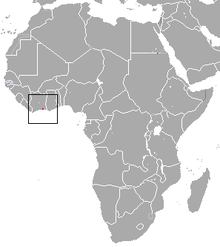Wimmer's shrew
| Wimmer's shrew | ||||||||||||
|---|---|---|---|---|---|---|---|---|---|---|---|---|
| Systematics | ||||||||||||
|
||||||||||||
| Scientific name | ||||||||||||
| Crocidura wimmeri | ||||||||||||
| Heim de Balsac & Aellen , 1958 |
Wimmer's shrew ( Crocidura wimmeri ) is a rare species of shrew from the genus of the white-toothed shrew ( Crocidura ). It occurs in the Ivory Coast in West Africa and is one of the ten most endangered vertebrate species. The species name refers to Eugène Wimmer, a former Swiss consul in Ivory Coast.
features
Wimmer's shrew resembles the Nimba shrew ( Crocidura nimbae ), the Fox musk shrew ( Crocidura foxi ) and the Nigeria musk shrew ( Crocidura nigeriae ) in their appearance as well as in skull and bite properties , but differs from the aforementioned species in details of the skull - and tooth structure. Size specifications are only known from two male type specimens, which were described by Henri Heim de Balsac and Villy Aellen in 1958 . The two specimens have a head-body length of 80 and 90 mm and a tail length of 57 mm each. The rear foot length is 17 mm each in both specimens. The length of the ears is not known. The total length of the upper row of teeth from the first incisor to the third molar is 12 or 11.3 mm. The skull width is 9.5 mm in the first specimen and 10.0 mm in the second. The skull length is 25 mm or 24 mm. The karyotype is 2n = 50, FN = 84. The back fur is dark ash gray to brown, the peritoneum is lighter. The relatively long tail is hairless. The skull is elongated, the facial area is well developed, and the jaws are wide.
Vocalizations
Wimmer's shrew differs from most other West African shrew species in its defense call, which has an average duration of 217 milliseconds and is played back at a frequency of 11.7 to 15.0 kHz .
Habitat and way of life
Wimmer's shrew lives in primary forests, secondary forests and moist swamp forests near the coast. The species is nocturnal. A study carried out by Peter Vogel in the mid-1970s on specimens kept in human care found that the animals were active for 340 minutes over 22 phases per day. Of this, 6 to 45 minutes were spent in the night hours, but only 0 to 4 minutes in the daytime hours. The energy consumption of a specimen weighing 23.5 g was 1.9 kilojoules per gram per hour.
status
Wimmer's shrew is listed by the IUCN in the “ critically endangered ” category. It was originally only known from Adiopodoumé in the south of the Ivory Coast, where it was last sighted in 1976. This species was subsequently suspected of becoming extinct until four specimens were rediscovered in Banco National Park in early 2008. In the terra typica , the habitat deterioration due to logging contributed to the disappearance of Wimmer's shrew.
literature
- Sara Churchfield, Paulina D. Jenkins: Wimmer's shrew. In: Jonathan Kingdon, Thomas M. Butynski, David CD Happold, Meredith Happold (Eds.): Mammals of Africa. Volume 4: Hedgehogs, shrews and bats. Bloomsbury, London et al. 2013, ISBN 978-1-4081-2254-9 , SS 145-146.
- H. Heim de Balsac, V. Aellen: Les Soricidae de basse Côte d'Ivoire. In: Revue Suisse de Zoologie. Vol. 65, 1958, ISSN 0035-418X , pp. 921-956, digitized version , (first scientific description).
Web links
- Crocidura wimmeri in the endangered Red List species the IUCN 2012. Posted by: Rainer Hutterer, 2008. Accessed July 28, 2013.
Individual evidence
- ↑ a b c d Blaise Kadjo, Roger Yao Kouadio, Valérie Vogel, Sylvain Dubey, Peter Vogel: Assessment of terrestrial small mammals and a record of the critically endangered shrew Crocidura wimmeri in Banco National Park (Côte d'Ivoire). In: Mammalia. Vol. 77, Issue 4, April 2013, ISSN 1864-1547 (online), ISSN 0025-1461 (print), pp. 1–8, doi : 10.1515 / mammalia-2012-0083 .
- ↑ Rainer Hutterer , Peter Vogel: Defensive sounds of African shrews of the genus Crocidura Wagler, 1832 and their systematic significance. In: Bonn Zoological Contributions. Vol. 28, No. 3/4, 1977, ISSN 0006-7172 , pp. 218-222, online (PDF; 3.12 MB) .
- ^ Peter Vogel: Energy consumption of European and African shrews. In: Acta Theriologica. Vol. 21, No. 13, 1976, ISSN 0001-7051 , pp. 195-206, online (PDF; 8.4 MB) ( Memento from November 11, 2013 in the Internet Archive ).
